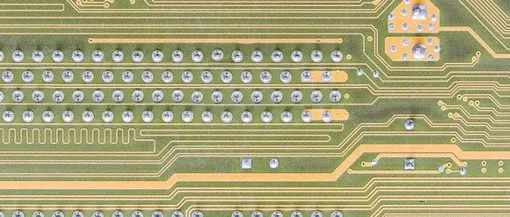Flexible Printed Circuit (FPC) boards can indeed be manufactured as four-layer structures, although the manufacturing process is more complex compared to double-layer or multi-layer FPCs. This complexity arises from considerations related to insulation properties, signal transmission, manufacturing processes, and application fields. Four-layer FPC boards offer advantages such as high space utilization, excellent flexibility, and lightweight, making them highly promising for use in high-end electronic products.
► Material Characteristics
FPC boards are primarily made from polyimide film as the base material. Through processes such as copper cladding, etching, and drilling, conductive patterns are formed, providing good flexibility and bendability. However, due to the unique structure of FPC boards, manufacturing four-layer boards is relatively complex. This is because insulation between conductive layers and the reliability of signal transmission must be carefully considered.
Insulation Properties: The polyimide film base material of FPC boards offers good insulation properties, meeting the insulation requirements for four-layer boards. During manufacturing, careful design and production of insulating layers between conductive layers are essential to ensure insulation performance.
Signal Transmission: Conductive copper foil is used for the conductive layers of FPC boards, offering excellent conductivity. However, four-layer boards have more conductive layers, necessitating higher reliability for signal transmission. Therefore, during design and manufacturing, considerations must be given to signal interference and crosstalk between conductive layers.
► Manufacturing Processes
Manufacturing four-layer FPC boards is more complex compared to double-layer or multi-layer FPC boards. The processes involved include:
Lamination: Multiple lamination processes are required to stack the conductive layers of four-layer FPC boards. During lamination, parameters such as temperature, pressure, and time must be controlled to ensure strong bonding between conductive layers.
Drilling: Multiple drilling processes are necessary for four-layer FPC boards to achieve electrical connections between conductive layers. Drilling requires precise control of hole diameter and position to ensure reliable electrical connections.
Etching: Multiple etching processes are required during the manufacturing of four-layer FPC boards to form conductive patterns. Etching processes must be carefully controlled in terms of etchant concentration and etching time to ensure pattern accuracy and quality.
► Application Fields
FPC boards are widely used in electronic products such as mobile phones, tablets, and automotive electronics. Four-layer FPC boards, compared to double-layer or multi-layer FPC boards, can provide more conductive layers, enabling more complex circuit designs and higher signal transmission rates. Therefore, four-layer FPC boards have broad application prospects in high-end electronic products.
► Advantages
Compared to traditional rigid boards or double-layer FPC boards, four-layer FPC boards offer the following advantages:

High Space Utilization: Four-layer FPC boards can accommodate more conductive layers within limited space, increasing circuit integration and space utilization.
Excellent Flexibility: FPC boards offer good flexibility and bendability, adapting to complex product shapes and curved designs.
Light Weight: Compared to traditional rigid boards, FPC boards are lighter, reducing the overall weight of products.



